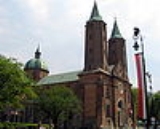
Masovian Blessed Virgin Mary Cathedral
Encyclopedia
Płock Cathedral, or the Cathedral of the Blessed Virgin Mary of Masovia, in Płock, is a Roman Catholic cathedral in Poland
, an example of Romanesque architecture
.
workshop about 1150. In the cathedral there is now a bronze replica of the doors, made in the 1980s. In the Royal Chapel on the north side of the cathedral is a marble sarcophagus forming the tomb of two Polish rulers, Władysław I Herman and his son Bolesław III Wrymouth.
Following a major fire in 1530, the building was reconstructed by Bishop Andzej Krzycki as a new Renaissance style church (1531–1535). This was the first large Renaissance style cathedral in Poland, although it reused granite ashlar portions of the Romanesque basilica. The architects were Bernardino de Gianotis from Rome
, Giovanni Cini da Siena and Philippo da Fiesole. The layout of the new cathedral was based on the Renaissance basilicas of Rome (Sant'Agostino
, Santa Maria del Popolo
). However the external architecture remains in the style of North Italian brick churches, more similar to local late Gothic ones in Masovia, and may be the result of rebuilding work about 1560 by Giovanni Battista of Venice
, who added the spacious choir and two western towers.
The building was restored in 1903, when the present design of the west front and towers was designed by the architect in charge of the restoration, Stefan Szyller.
Poland
Poland , officially the Republic of Poland , is a country in Central Europe bordered by Germany to the west; the Czech Republic and Slovakia to the south; Ukraine, Belarus and Lithuania to the east; and the Baltic Sea and Kaliningrad Oblast, a Russian exclave, to the north...
, an example of Romanesque architecture
Romanesque architecture
Romanesque architecture is an architectural style of Medieval Europe characterised by semi-circular arches. There is no consensus for the beginning date of the Romanesque architecture, with proposals ranging from the 6th to the 10th century. It developed in the 12th century into the Gothic style,...
.
History
The bishopric in Płock was founded about 1075. The first definite reference to the cathedral is in 1102, when Władysław I Herman was buried there. The present Romanesque cathedral was built after 1129 by prince Bolesław III and Bishop Aleksander of Malonne. This was a rebuilding following a fire and took from 1136 until 1144. It was consecrated in 1144 as the Church of the Blessed Virgin Mary. The original bronze doors of the Romanesque cathedral (now in Velikiy Novgorod) have figurative bas-reliefs depicting the verses of the so-called "Roman Confession of Faith", and the figure of Alexander of Malonne, bishop of Płock. The doors were made in the MagdeburgMagdeburg
Magdeburg , is the largest city and the capital city of the Bundesland of Saxony-Anhalt, Germany. Magdeburg is situated on the Elbe River and was one of the most important medieval cities of Europe....
workshop about 1150. In the cathedral there is now a bronze replica of the doors, made in the 1980s. In the Royal Chapel on the north side of the cathedral is a marble sarcophagus forming the tomb of two Polish rulers, Władysław I Herman and his son Bolesław III Wrymouth.
Following a major fire in 1530, the building was reconstructed by Bishop Andzej Krzycki as a new Renaissance style church (1531–1535). This was the first large Renaissance style cathedral in Poland, although it reused granite ashlar portions of the Romanesque basilica. The architects were Bernardino de Gianotis from Rome
Rome
Rome is the capital of Italy and the country's largest and most populated city and comune, with over 2.7 million residents in . The city is located in the central-western portion of the Italian Peninsula, on the Tiber River within the Lazio region of Italy.Rome's history spans two and a half...
, Giovanni Cini da Siena and Philippo da Fiesole. The layout of the new cathedral was based on the Renaissance basilicas of Rome (Sant'Agostino
Sant'Agostino
Sant'Agostino is a church in Rome, Italy, not far from Piazza Navona. It is one of the first Roman churches built during the Renaissance. The construction was funded by Guillaume d'Estouteville, Archbishop of Rouen and Papal Chancellor. The façade was built in 1483 by Giacomo di Pietrasanta, using...
, Santa Maria del Popolo
Santa Maria del Popolo
Santa Maria del Popolo is an Augustinian church located in Rome, Italy.It stands to the north side of the Piazza del Popolo, one of the most famous squares in the city. The Piazza is situated between the ancient Porta Flaminia and the park of the Pincio...
). However the external architecture remains in the style of North Italian brick churches, more similar to local late Gothic ones in Masovia, and may be the result of rebuilding work about 1560 by Giovanni Battista of Venice
Venice
Venice is a city in northern Italy which is renowned for the beauty of its setting, its architecture and its artworks. It is the capital of the Veneto region...
, who added the spacious choir and two western towers.
The building was restored in 1903, when the present design of the west front and towers was designed by the architect in charge of the restoration, Stefan Szyller.
See also
- Płock Diadem
- Dukes of MasoviaDukes of MasoviaThe Dukes of Masovia were a line of the Piast dynasty who ruled in Masovia. The following is a list of all rulers of the Duchy of Masovia and its parts...
- www.katedraplock.pl - website of Płock Cathedral

